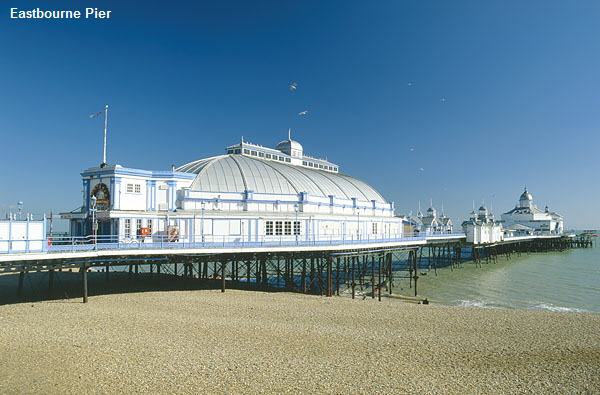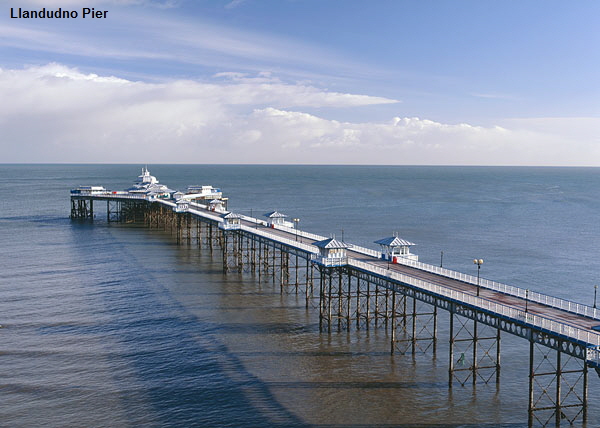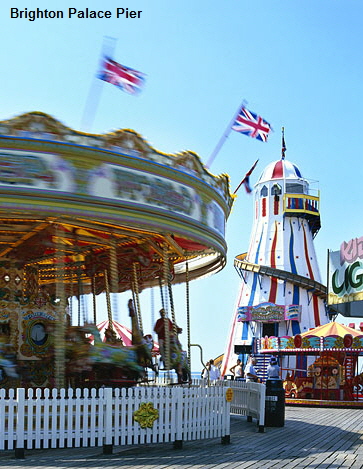|
Piers of the Realm
Despite the fire and storm damage, over 50 of our Victorian seaside piers are all going strong. Craig Roberts admires the views, from Brighton to Bangor.
 |
The pier has always been very much a British icon but, although Scotland has its fair share of jetties and landing stages – which is the reason piers were originally built – it is a seaside feature that is almost exclusive to England and Wales.
Today, we have some 55 jutting out from around our coastline – that includes the Grand Pier at Weston-super- Mare, recently gutted by fire; although the owners and the local council have both pledged to restore it.
During the 18th century it was fashionable to “take the waters” in spa towns such as Harrogate, Boston Spa and Bath. People felt that their curative mineral springs improved their health. Then, in the early 1700s, when physician Sir John Floyer proclaimed the virtues of sea water – both for bathing and for drinking – coastal towns also became popular resorts.
The addition of a mineral spring that was discovered on the beach at Scarborough, heralded the beginning of the “seaside watering-place”, and it was not long before coastal towns surpassed the spas in popularity.
It was when it became clear that these new visitors needed an easier and more dignified way to get ashore from the steam passenger ships on which they arrived, the idea of the pier was born. Until then, this had been done either by rowing to the beach in a small boat or by being carried by a porter, piggyback style, through the waves.
Ryde, on the Isle of Wight, prided itself as the first town to provide a suitable landing stage. Built between 1812 and 1814, it was 1,740 feet long on completion. A basic design with no decoration, it was, however, an immediate success, so much so that it quickly doubled in length as the traffic increased.
Brighton followed this in 1823, with its famous Royal Suspension Chain Pier, with its four stone towers hung with steel support cables.
By the 1840s, piers had taken on new roles by acting as promenades and it was soon apparent to the owners that a profit could be made from these casual strollers who wished to walk from the main promenade out above the sea. It was also around this time that the middle, as well as the upper, classes were making their way to these new resorts, thanks largely due to the building of the railways. It was then that a new kind of pier was introduced: the pleasure pier.
 |
There is, however, a slight disagreement as to who first came up with the idea. The Wellington Pier in Great Yarmouth opened first, in 1854, although the citizens of Southport had conceived the idea for a pleasure pier back in the 1840s. Their pier did not open until 1860 and, at 3,600 feet, which rapidly expanded to 4,380 feet, it was for some years the longest pier in the country. It was also on the regular paddlesteamer route that serviced Llandudno and Blackpool.
These structures quickly expanded to include pavilions and theatres with live shows and entertainment. Military bands set toes tapping, while end-of-the-pier shows with pierrots and other performers brought a touch of jaunty, raffish glamour to the sea.
Back in Brighton, the West Pier opened in 1866 as a pleasure pier alongside the Chain Pier. A most lavish construction that featured ornamental kiosks and many souvenir stalls, it was the pinnacle of piers, designed by Eugenius Birch, a man who became to pier design what Brunel was to bridges.
Born in London in 1818, Birch was the son of an architect and surveyor who as a boy showed promise in the field of engineering by submitting an idea for a carriage to the London and Birmingham Railway.
Encouraged to pursue a career in civil engineering, he could see a great future in piers. As well as Brighton West, his other designs included piers for Margate, which was his first, as well as Eastbourne, Scarborough, Hastings and Bournemouth, a total of 14 in all, before his death in 1884.
The popularity of the West Pier in Brighton increased dramatically when the Chain Pier was destroyed by a storm in 1896 ahead of its planned demolition due to sustained damage, giving way to the new Palace Pier (now called Brighton Pier and still going strong). The West Pier was frequently hit by storms and was subsequently closed, leaving it under threat of demolition ever since.
Two arson attacks, in 2003, have all but destroyed what remained of it and its future now rests with plans for a vertical observation tower, the i360 or “Brighton Eye”, which could help to fund its reconstruction.
By the 1870s, Sussex had five piers open and another at Hastings under construction.
The Bank Holidays Act of 1871 aided them in their success, as it enabled some workers to have a minimum number of days off, including the August Bank Holiday, during the year.
All piers are vulnerable to weather and fire damage and in the north of England, piers have suffered their share of misfortunes and setbacks. In Yorkshire, both Coatham and Withernsea’s were hit by storms and, subsequently, destroyed. Redcar pier now barely survives after ships repeatedly collided with it, and even the Birch-designed pier at Scarborough was wrecked by a storm in 1905 and demolished in 1914.
Saltburn, the last survivor of these elegant structures that once graced the Yorkshire coast, was designed by John Anderson and opened in 1869. It culminated in the addition of a bandstand in 1885, which was lost when struck by a ship in 1924. Its mock Tudor entrance buildings are as recent as 1910 and it now stands at 681 feet long, but still features the original Victorian ironwork.
Over in Blackpool, a town built on entertainment, there are no less than three piers. The North Pier, the oldest of the three, was designed by Eugenius Birch and opened in 1863. The Central Pier was opened five years later and although the North Pier has always been regarded as the superior of the three, the Central has always drawn the crowds. The South Pier, which was the shortest, opened in 1893. Noted for its brass band concerts, it has suffered the most damage, with major fires destroying its shops, amusements and theatre, although these have been rebuilt.
In Wales, Llandudno has a pier still regarded by many as the best in Britain. All that remains of its winter gardenstyle pavilion, that was built in 1883 and opened in 1886, are the ironwork support columns and iron stairs that lead only to the sky.
 |
Another fine example of Victorian engineering is the Garth Pier in Bangor that reaches two-thirds of the way across the Menai Strait. With its ornamental ironwork and kiosks along its 1,500 feet, it was opened in 1896. It closed in 1971 due to damage, but was fully restored by 1988.
At Mumbles Head that overlooks Swansea Bay, is a pier that was opened in 1898 at a cost of £17,000 and provided regular excursions across the Bristol Channel to North Devon. It now has the lifeboat station on a spur attached to it.
 |
The prize for the longest pier goes to Southend in Essex. Opened in 1830 it was originally 1,800 feet long but was extended to nearly 7,000 feet, almost twice as long as the preceding record-holder, Southport Pier. Southend Pier is served by its own electric railway running alongside the promenade deck and was the first to do so. In 1888 the pier’s original wooden design was replaced by an iron construction, designed by James Brunlees, also the architect of Southport Pier.
Between 1813 and 1910, 84 piers were built in Britain. Since then, the National Piers Society estimates that we have lost 36 of them.
With the tangled wreckage of Weston-super-Mare’s once magnificent Grand Pier seen in the news recently, it can only be hoped that our love of this great British symbol will not let it languish. We must ensure the survival of the seaside pier.
All images and text copyright © Craig Roberts 2008
|